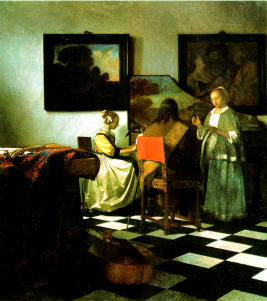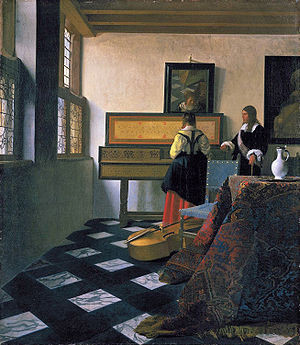Leave it to a pair of magicians to take the magic out of a great work of art, then raise even deeper questions than they answer. TIM’S VERMEER floored me. It really messed with my head. Dutch master painter Johannes Vermeer (1632-1675), known for his extraordinary sense of composition, pristine technique, and light–his canvases seem to radiate an otherworldly glow of their own– painted relatively few works of art in his brief lifetime; only 34 paintings have been ascribed to him, one of which,”The Concert” (1658-60), was stolen in the biggest art heist in history at Boston’s Isabella Stewart Gardner Museum. Has he perhaps been robbed again!?
Produced by Penn Jillette and directed by Teller of “Penn and Teller ” fame– that debunking duo of magicians known for revealing almost as much as they hide–TIM’S VERMEER has turned our attention to a man as curious and obsessed as they are– and I don’t mean Vermeer. The film documents the quest of one very wealthy, brilliant and extraordinarily gifted inventor and self-described “computer graphics guy ” named Tim Jenison who set out to uncover the techniques Vermeer used in creating his rarefied masterpieces.
Jenison starts by building on previous speculation about the use of optics in paintings of the period. Optics were all the rage in 17th century Holland. Antonie Von Leeuwenhoek, the perfecter of the microscope, was a contemporary of Vermeer’s and the executor of Vermeer’s will! British painter David Hockney had already published a work suggesting that Vermeer along with other Renaissance painters may have used a camera obscura and various mirrors to achieve a photo-realistic effect. That Vermeer’s formal training as a painter was somewhat mysterious, and that he left no sketches as substrate for his work, bolsters the premise.
Here’s where the film blows my mind. Jenison comes up with a theory involving a camera obscura and the ingenious positioning of a concave mirror in a controlled space that might explain how Vermeer did it. Then he goes to “eleven.” Jenison decides to prove his hypothesis by attempting to RECREATE one of Vermeer’s actual paintings– and we watch him do it. WHAT???
The painting he decides to recreate is “The Music Lesson” a.k.a. “A Lady at the Virginals with a Gentleman.” One problem? It’s located in Buckingham Palace as part of the Queen’s Royal Collection and Jenison is only allowed ONE private viewing, for exactly 30 minutes. Furthermore, in order to make his experiment absolutely scientifically sound, Jenison limits himself to using only the tools and materials that would have been available to Vermeer himself. In other words, he will use only those lenses, pigments, brushes, canvases, furniture, windows, costumes available in 17th century Holland–and that means he has to gather or MAKE all of these items because they do not currently exist. So with a Lear jet at his disposal, he sets off around the world to gather what he needs and do exactly that. He also manages to grind lenses, become a woodworker, make windows, gather and mix pigments–among them the extremely costly lapis lazuli.
Then he has to stage the composition which he does on location in a garage in Texas! Now, the real work begins: he has to PAINT it. Understand, Jenison is not a painter. In fact, he has had no formal training in any of the aforementioned disciplines, any single one of which requires extraordinary motor skills, patience, focus, ARTISTRY, and scientific precision. The film takes its time, meticulously observing–Vermeer-like–every step of Jenison’s quest and effort. Personalities as diverse as Martin Mull, David Hockney, and Penn Jillette weigh in. Then the film slows down to a brush stroke, documenting every dab of paint, every turn of the lathe, every set back; and yes, the tension builds. My jaw was on the floor as I watched this years-long herculean effort unfold slowly, meticulously. Be patient: the result is staggering.
Like Adam and Eve in The Garden, however, I don’t know what to do with this knowledge. I cannot un-know it. But I don’t know what it means. Is Vermeer a great artist? A great scientist? What is art? Is this the magical place where science and art meet?? See TIM’S VERMEER; I believe the proof is in the canvases– Vermeer’s and Tim’s. But beware snakes in the grass.








[…] “Leave it to a pair of magicians to take the magic out of a great work of art, then raise even deeper questions than they answer.” – Joyce Kulhawik, Joyce’s Choices […]